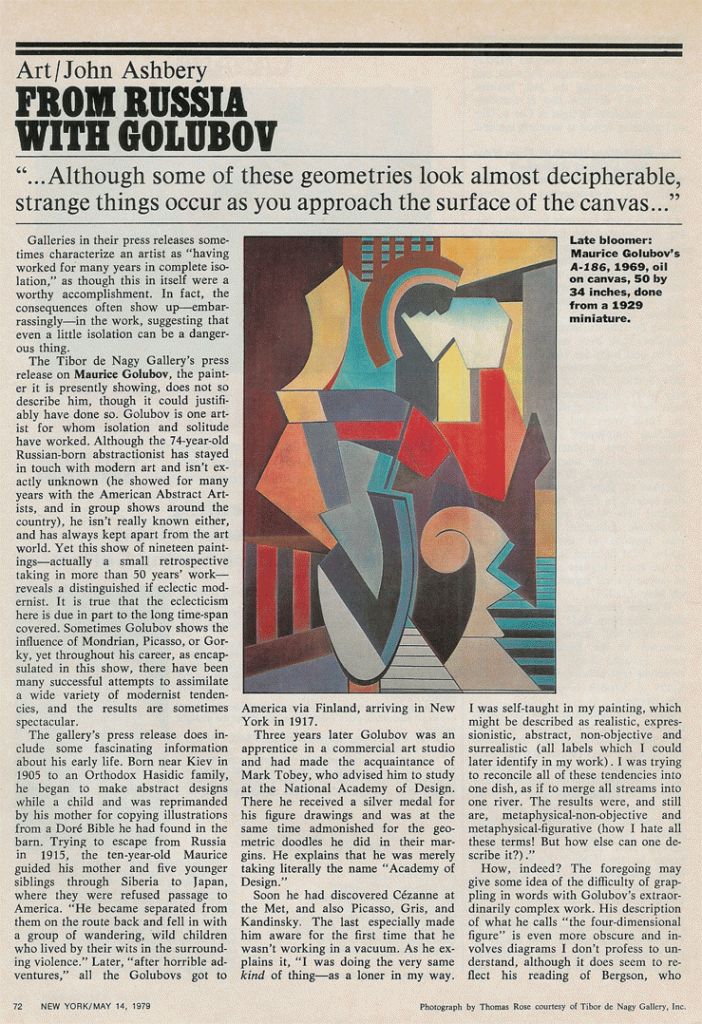This article was written by John Ashbery and published in the May 14 1979 edition of the New York Magazine.
Galleries in their press releases sometimes characterize an artist as “having worked for many years in complete isolation,” as though this in itself were a worthy accomplishment. In fact, the consequences often show up – embarrassingly – in the work, suggesting that even a little isolation can be a dangerous thing.
The Tibor de Nagy Gallery’s press release on Maurice Golubov, the painter it is presently showing, does not so describe him, though it could justifiably have done so. Golubov is one artist for whom isolation and solitude have worked. Although the 74-year-old Russian-born abstractionist has stayed in touch with modern art and isn’t exactly unknown (he showed for many years with the American Abstract Artists, and in group shows around the country), he isn’t really known either, and has always kept apart from the art world. Yet this show of nineteen paintings – actually a small retrospective taking in more than 50 years’ work – reveals a distinguished if eclectic modernist. It is true that the eclecticism here is due in part to the long time-span covered. Sometimes Golubov shows the influence of Mondrian, Picasso, or Gorky, yet throughout his career, as encapsulated in this show, there have been many successful attempts to assimilate a wide variety of modernist tendencies, and the results are sometimes spectacular.
The gallery’s press release does include some fascinating information about his early life. Born near Kiev in 1905 to an Orthodox Hasidic family, he began to make abstract designs while a child and was reprimanded by his mother for copying illustrations from a Dore’ Bible he had found in the barn. Trying to escape from Russia in 1915, the ten-year-old Maurice guided his mother and give younger siblings through Siberia to Japan, where they were refused passage to America. “He became separated from them on the route back and fell in with a group of wandering, wild children who lived by their wits in the surrounding violence.” Later, “after horrible adventures,” all the Golubovs got to America via Finland, arriving in New York in 1917.
Three years later Golubov was an apprentice in a commercial art studio and had made the acquaintance of Mark Tobey, who advised him to study at the National Academy of Design. There he received a silver medal for his figure drawings and was at the same time admonished for the geometric doodles he did in their margins. He explains that he was merely taking literally the name “Academy of Design.”
Soon he had discovered Cezanne at the Met, and also Picasso, Gris, and Kandinsky. The last especially made him aware for the first time that he wasn’t working in a vacuum. As he explains it, “I was doing the very same kind of thing – as a longer in my way. I was self-taught in my painting, which might be described as realistic, expressionistic, abstract, non-objective and surrealistic (all labels which I could later identify in my work). I was trying to reconcile all of these tendencies into one dish, as if to merge all streams into one river. The results were, and still are, metaphysical-non-objective and metaphysical-figurative (how I hate all these terms! But how else can one describe it?).”
How, indeed? The foregoing may give some idea of the difficulty of grappling in words with Golubov’s extraordinarily complex work. His description of what he calls “the four-dimensional figure” is even more obscure and involves diagrams I don’t profess to understand, although it does seem to reflect his reading of Bergson, who “taught that God was still in the process of evolution, and that the final stage – the ‘Absolute,’ as he called it – was even beyond the Infinite, and was incomprehensible to the human brain, which could handle only a limited number of vibrations.” Golubov, it seems would like to add, if ever so slightly, to the brain’s capacity for receiving vibrations, and in so doing reveal an aspect of “the Absolute.”
Two of the paintings in the show, A-186 and A-253, done in oil in the late sixties, are large-scale versions of tiny gouache studies from 40 years before, when Golubov couldn’t afford to buy canvas, and they surely set some kind of record for artistic gestation. There seems to be little traceable thematic progression through the years – he returns to early themes or invents new ones with a proper disdain for chronology. The masterpiece in the show, I think, is Fourth of July, a dizzying jigsaw puzzle of unidentifiable but strangely familiar shapes, suffused in a rainbow of violent pastel tones, that was painted in 1971 yet suggests his Cubist-derived pictures of the twenties.
Although some of these geometries look almost decipherable, strange things happen as one approaches the surfgace of the canvas. There are tricks in the handling of paint that undercut the seeming solidity of the design: Small pools of “painterless” created with a tiny brush, like Mondrian’s finely striated surfaces, adjoin areas where the brush was wider and looser yet still conformed to the strictures of the composition. Elsewhere color seems to have been floated mysteriously onto the canvas. In one painting I noticed a brush-stroke that passed from one color zone into another: Its track was uninterrupted yet bicolored.
Bold and subtle, complex yet projecting a uniform glow, these “cityscapes of the mind,” as one critic called them, offer you a great deal to unravel, and, more important, give you the urge to do so. (29 West 57th Street, through May 10.)
